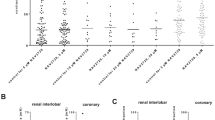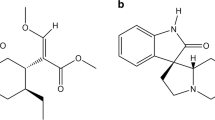Summary
The mechanisms by which co-dergocrine mesylate (CODE) and its components modify vascular tone was investigated in vitro. Changes in tension were monitored isometrically on spiral strips of canine basilar arteries and femoral veins suspended in 10 ml organ baths and on spiral strips of canine saphenous veins superfused between two platinum electrodes for electric stimulation (150 mA, 0.1 ms, 2 Hz) and measurement of tritium overflow. Cumulative concentration-response curves were established for, 5-hydroxytryptamine (5-HT), noradrenaline (NA), dihydroergocornine (DHCO), dihydroergocristine (DHEC), dihydro-α-ergokryptine (DHαE), dihydro-β-ergokryptine (DHβE) and CODE. CODE and its single components were about equally potent in antagonizing responses to 5-HT on basilar arteries. On femoral veins DHEC antagonized responses to NA noncompetitively whereas the other components caused competitive antagonism against NA. Compared to CODE DHαE and DHβE, the α-blocking potency of both DHCO and DHEC was about 10 times weaker. All 5 ergot compounds were about equally potent in antagonizing contractile responses to electric stimulation of saphenous veins whereas the stimulation-induced overflow of labeled NA was inhibited in the following order of potency: CODE≧DHCO > DHαE > DHβE > DHEC. The 5 ergot compounds stimulated arterial and venous smooth muscle at slightly higher concentrations than necessary for antagonism of 5-HT or NA. Evidence is presented that the mechanism of the stimulant action on arteries differs from that on veins.
It is suggested that the diversity of actions of CODE is the base for its therapeutic effectiveness in patients suffering from regional vascular disorders.
Similar content being viewed by others
References
Aellig WH, Berde B (1969) Studies of the effect of natural and synthetic polypeptide type ergot compounds on a peripheral vascular bed. Br J Pharmacol 36:561–570
Barcroft H, Konzett H, Swan HJC (1951) Observations on the action of the hydrogenated alcaloids of the ergotoxine group on the circulation in man. J Physiol 112:273–291
Barthel W, Grossman K (1980) The effect of dihydrogenated ergot alkaloids on the capacitance reaction in the lower limb of man. 5th symposium on clinical Pharmacology, Pécs, Hungary, May 28–30
Bluntschli HJ, Goetz RH (1948) The effect of ergot derivatives on the circulation in man with special reference to two new hydrogenated compounds (dihydroergotamine and dihydroergocornine). Am Heart J 35:873–894
Clark BJ, Chu D, Aellig WH (1978) Actions on the heart and circulation. In: Berde B, Schild HO (eds) Ergot alkaloids and related compounds. Handb exp Pharmacol. Springer, Berlin Heidelberg New York, pp 321–420
Closse A, Bolliger G, Dravid A, Frick W. Pfäffli P, Sauter A, Tobler HJ (1981) Structural modifications of the ergopeptine molecule and their differential influence on the affinities to different receptor binding sites, a structure affinity analysis. In: Molecular pharmacology of neurotransmitter receptor systems. Proceedings of the satelite symposium of the 8th international congress of pharmacology, Hiroshima (in press)
Coimbra A, Ribeiro-Silva A, Osswald W (1974) Fine structural and autoradiographic study of the adrenergic innervation of the dog lateral saphenous vein. Blood Vessels 11:128–144
Delius L, Hammerschmidt D, Odenthal F (1949) Klinisch-experimentelle Untersuchungen über die kreislaufdynamischen Wirkungen der dihydrierten Mutterkornalkaloide. Klin Wochenschr 27:33–34
Ehringer H (1970) Zur Wirkung von reinem Dihydroergocristin auf Extremitätendurchblutung und periphere Venentonisierung des Menschen. Int J Clin Pharmacol Ther Toxicol 3:81–86
Freis ED, Stanton JR, Wilkins RW (1948) The effect of certain dihydrogenated alkaloids of ergot in hypertensive patients. Am J Med Sci 216:163–171
Haley TJ, McCormick WG (1955) Effect of ergotamine and hydergine on muscle blood flow in the dog. Fed Prog 14:348
Hammerschmidt D, Odenthal F (1950) Über die Wirkung der hydrierten Mutterkornalkaloide auf den arteriellen und venösen Blutdruck. Z Kreislaufforsch 39:150–160
Härich BKS, Nissen H, Stauch M (1975) Die Alpha-Sympathikolyse im arteriellen und venösen Kreislaufschenkel nach Hydergin. Herz-Kreislauf 7:194–198
Kappert A (1949) Untersuchungen über die Wirkungen neuer dihydrierter Mutterkornalkaloide bei peripheren Durchblutungsstörungen und Hypertonie. Helv Med Acta 16, Suppl. 22:27–64
Maclay WP (1979) Vasodilators in senile dementia. Br Med J 2:(6194): 866
Müller-Schweinitzer E (1974) Studies on the peripheral mode of action of dihydroergotaminc in human and canine veins. Eur J Pharmacol 27:231–237
Müller-Schweinitzer E (1976) Responsiveness of isolated canine cerebral and peripheral arteries to ergotamine. Arch Pharmacol 292:113–118
Müller-Schweinitzer E (1979) On the pharmacology of venous smooth muscle from dog and man. Folia Haematol (Leipzig) 106:690–704
Müller-Schweinitzer E (1980) Actions of ergot alkaloids at specific receptors in vascular smooth muscle. Prog Pharmacol 3/4:87–99
Müller-Schweinitzer E (1981) Agonist potencies of tryptamine derivatives at pre-and postjunctional receptors in canine saphenous vein. Postgr Med J 55 (Suppl 1):33–41
Müller-Schweinitzer E, Brundell J (1975a) Enhanced prostaglandin synthesis contributes to the venoconstrictor activity of ergotamine. Blood Vessels 12:193–205
Müller-Schweinitzer E, Brundell J (1975b) Modification of canine vascular smooth muscle responses to dihydroergotamine by endogenous prostaglandin synthesis. Eur J Pharmacol 34:197–206
Müller-Schweinitzer E, Weidmann H (1977) Regional differences in the responsiveness of isolated arteries from cattle dog and man. Agents Actions 7:383–389
Müller-Schweinitzer E, Weidmann H (1978) Basic pharmacological properties. In: Berde B, Schild HO (eds) Ergot alkaloids and related compounds. Handb exp Pharmacol. Springer, Berlin Heidelberg New York, pp 87–232
Neutlaus G, Birtel FJ, Hahn N, Hierlwimmer A, Malottky D (1976) Einfluß von Dihydro-Ergocornin,-Ergokryptin und-Ergocristin auf die Hämodynamik im experimentellen kardiogenen Schock. Prakt Anästh 11:68–76
Northover BJ (1971) Mechanism of the inhibitory action of indomethacin on smooth muscle. Br J Pharmacol 41:540–551
Rorie DK, Muldoon SM, Tyce GM (1980) The specific activity of retained and release norepinephrine in dog saphenous vein prelabeled with radiolabeled norepinephrine. Life Sc 26:707–714
Trêves R, Pitrou E, Clément A, Dibon J-M, Desproges-Gotteron R (1979) Acrosyndrome par association. Dihydroergocristine-Triacétyloléandromycine. Concours Med 101:4581
Ulrich J, Jessen B, Siggaard Andersen J (1973) Comparative effects of dihydroergotamine and hydergine on the blood flow, capillary filtration rate and the capacitance vessels in the human calf studies by plethysmography. Angiology 24:657–663
Vanhoutte PM (1974) Inhibition by acetylcholine of adrenergic neurotransmission in vascular smooth muscle. Circ Res 34:317–326
Van Rossum JM (1963) Cumulative dose-response curves (II. Technique for the making of dose-response curves in isolated organs and the evaluation of drug parameters). Arch Int Pharmacodyn 143:299–330
Vogler E (1954) Angiographische Beiträge zur Entstehung von Gefäßerkrankungen und Durchblutungsstörungen unter besonderer Berücksichtigung der terminalen Strombahn. Fortschr Röntgenstr 81:479–497
Yamamoto M, Meyer JS (1980) Hemicranial disorder of vasomotor adrenoceptors in migraine and cluster headache. Headache 20:321–335
Author information
Authors and Affiliations
Rights and permissions
About this article
Cite this article
Müller-Schweinitzer, E. Actions of Co-Dergocrine mesylate and its components at vascular smooth muscle. Naunyn-Schmiedeberg's Arch. Pharmacol. 318, 225–233 (1982). https://doi.org/10.1007/BF00500484
Received:
Accepted:
Issue Date:
DOI: https://doi.org/10.1007/BF00500484




